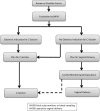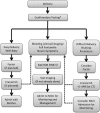A Practical Guide to the Management of the Fetus and Newborn With Hemophilia
- PMID: 30373387
- PMCID: PMC6714852
- DOI: 10.1177/1076029618807583
A Practical Guide to the Management of the Fetus and Newborn With Hemophilia
Abstract
Newborns with hemophilia are at risk of intracranial hemorrhage, extracranial hemorrhage, and other bleeding complications. The safe delivery of a healthy newborn with hemophilia is a complex process that can begin even before conception, and continues throughout pregnancy, birth, and the newborn period. This process involves the expectant parents and a wide variety of health-care professionals: genetic counselors, obstetricians, neonatologists, pediatricians, radiologists, adult and pediatric hematologists, and nurses with expertise in hemophilia. Because of this multidisciplinary complexity, the relative rarity of births of newborns with hemophilia, and the lack of high-quality evidence to inform decisions, there is considerable variation in practice in this area. We present a comprehensive multidisciplinary approach, from preconception counseling to discharge planning after birth, and describe available options for management decisions. We highlight a number of areas of important uncertainty and controversy, including the preferred mode of delivery, the appropriate use and timing of neuroimaging tests, and the appropriate use of clotting factor concentrates in the newborn period. While the approach presented here will aid clinicians in planning and providing care, further research is required to optimize the care of newborns with hemophilia.
Keywords: bleeding; gynecology and obstetrics; hemophilia.
Conflict of interest statement
Figures



Similar articles
-
Considerations for shared decision management in previously untreated patients with hemophilia A or B.Ther Adv Hematol. 2023 Apr 17;14:20406207231165857. doi: 10.1177/20406207231165857. eCollection 2023. Ther Adv Hematol. 2023. PMID: 37113810 Free PMC article. Review.
-
Current practices regarding newborn intracranial haemorrhage and obstetrical care and mode of delivery of pregnant haemophilia carriers: a survey of obstetricians, neonatologists and haematologists in the United States, on behalf of the National Hemophilia Foundation's Medical and Scientific Advisory Council.Haemophilia. 1999 Nov;5(6):410-5. doi: 10.1046/j.1365-2516.1999.00357.x. Haemophilia. 1999. PMID: 10583528
-
Guideline on the management of haemophilia in the fetus and neonate.Br J Haematol. 2011 Jul;154(2):208-15. doi: 10.1111/j.1365-2141.2010.08545.x. Epub 2011 May 9. Br J Haematol. 2011. PMID: 21554256 Review.
-
Hemophilia: a practical approach to genetic testing.Mayo Clin Proc. 2005 Nov;80(11):1485-99. doi: 10.4065/80.11.1485. Mayo Clin Proc. 2005. PMID: 16295028 Review.
-
Perinatal aspects of haemophilia.Eur J Haematol Suppl. 2014 Aug;76:21-5. doi: 10.1111/ejh.12371. Eur J Haematol Suppl. 2014. PMID: 24957104 Review.
Cited by
-
Considerations for shared decision management in previously untreated patients with hemophilia A or B.Ther Adv Hematol. 2023 Apr 17;14:20406207231165857. doi: 10.1177/20406207231165857. eCollection 2023. Ther Adv Hematol. 2023. PMID: 37113810 Free PMC article. Review.
-
Impact of Replacement Therapy on Pregnancy Outcomes in Hemophilia Carriers: A Historical Cohort Study in Saudi Arabia.Life (Basel). 2024 May 11;14(5):623. doi: 10.3390/life14050623. Life (Basel). 2024. PMID: 38792643 Free PMC article.
-
Mobile Health Technology for the Personalized Therapy of Hemophilia.Front Med (Lausanne). 2021 Aug 10;8:711973. doi: 10.3389/fmed.2021.711973. eCollection 2021. Front Med (Lausanne). 2021. PMID: 34447770 Free PMC article. Review.
-
Transplanting FVIII/ET3-secreting cells in fetal sheep increases FVIII levels long-term without inducing immunity or toxicity.Nat Commun. 2023 Jul 14;14(1):4206. doi: 10.1038/s41467-023-39986-1. Nat Commun. 2023. PMID: 37452013 Free PMC article.
-
Multisystem inflammatory syndrome in a neonate with severe hemophilia - a diagnostic challenge in COVID times: a case report.BMC Pediatr. 2022 Jul 7;22(1):397. doi: 10.1186/s12887-022-03463-3. BMC Pediatr. 2022. PMID: 35799157 Free PMC article.
References
-
- Yoffe G, Buchanan GR. Intracranial hemorrhage in newborn and young infants with hemophilia. J Pediatr. 1988;113(2):333–336. - PubMed
-
- Stieltjes N, Calvez T, Demiguel V, et al. Intracranial haemorrhages in French haemophilia patients (1991-2001): clinical presentation, management and prognosis factors for death. Haemophilia. 2005;11(5):452–458. - PubMed
-
- Miles BS, Anderson P, Agostino A, et al. Effect of intracranial bleeds on the neurocognitive, academic, behavioural and adaptive functioning of boys with haemophilia. Haemophilia. 2012;18(2):229–234. - PubMed
-
- Kulkarni R, Soucie JM, Lusher J, et al. Sites of initial bleeding episodes, mode of delivery and age of diagnosis in babies with haemophilia diagnosed before the age of 2 years: a report from The Centers for Disease Control and Prevention’s (CDC) Universal Data Collection (UDC) project. Haemophilia. 2009;15(6):1281–1290. - PubMed
Publication types
MeSH terms
LinkOut - more resources
Full Text Sources
Medical

